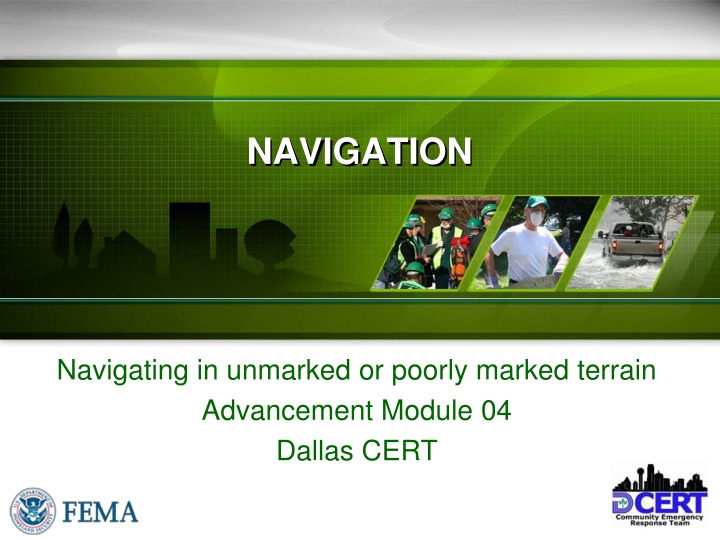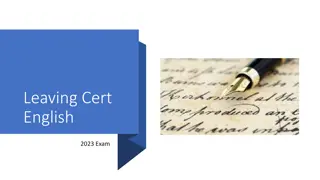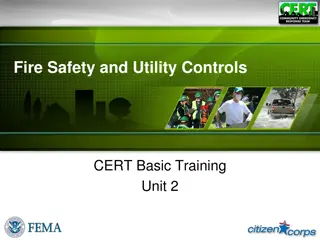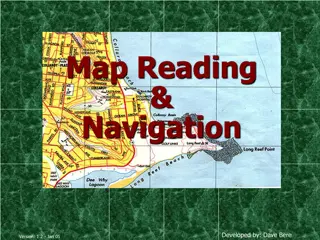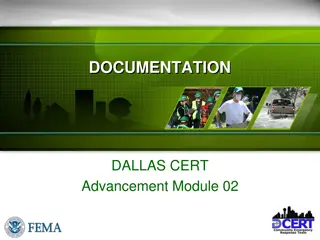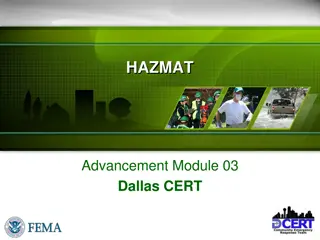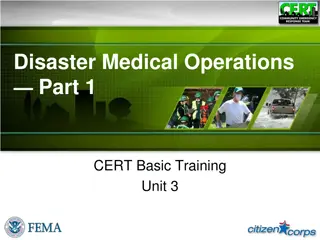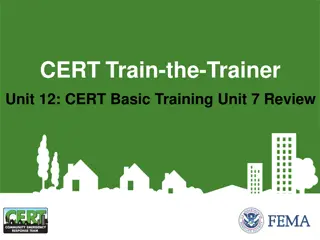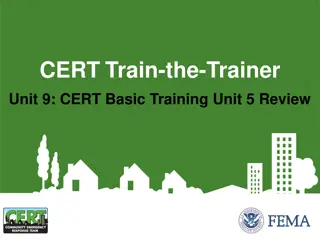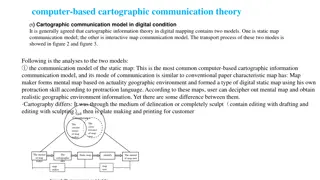Navigating Techniques without a Map: CERT Training Guide
Gain essential navigation skills for unmarked or poorly marked terrains through this module. Learn methods for navigating without a map, using a map effectively, and preparing mentally for getting lost. Discover the importance of carrying a compass, knife, and matches for CERT team members. Master the art of taking bearings using different types of compasses like lensatic and base plate models in this comprehensive navigation guide.
Download Presentation

Please find below an Image/Link to download the presentation.
The content on the website is provided AS IS for your information and personal use only. It may not be sold, licensed, or shared on other websites without obtaining consent from the author.If you encounter any issues during the download, it is possible that the publisher has removed the file from their server.
You are allowed to download the files provided on this website for personal or commercial use, subject to the condition that they are used lawfully. All files are the property of their respective owners.
The content on the website is provided AS IS for your information and personal use only. It may not be sold, licensed, or shared on other websites without obtaining consent from the author.
E N D
Presentation Transcript
NAVIGATION Navigating in unmarked or poorly marked terrain Advancement Module 04 Dallas CERT
Navigation Objectives This unit provides: Methods for navigating without a map Using a map to navigate Preparation for navigating in an unmarked disaster scene Mental preparation for being lost
Navigation Prepare CERT team members should consider carrying a compass in their kit Other basic equipment should include a knife and matches Complete this unit to be prepared to navigate on your own or with a team
Compass Types Lensatic Base Plate
Compass Parts Good compasses are typically liquid filled
Compass layout A compass is based on a circle divided into 360 degrees. These degree divisions are used as a notation to describe directions in relation to North. On a compass, North is at zero degrees, East is at 90 degrees, South is at 180 degrees, and West is at 270 degrees.
Compass Taking a bearing-baseplate Hold the compass level and point the direction of travel arrow at a landmark that is in the direction you need to go Rotate the compass until the orienting arrow lines up with the needle, pointing to the North Sight along the direction of travel arrow in the direction of the landmark and note the degree mark on the compass that corresponds to that direction that is your bearing
Taking a bearing baseplate This diagram illustrates a bearing of 330 degrees N baseplate Direction of travel arrow Compass needle Orienting arrow (which is part of the dial on the compass)
Taking a bearing lensatic With the Lensatic set the arm with the small lens so it leans at about a 45% angle with respect to the base of the compass. Line up the small slot in the arm with a) the hairline in the compass top and b) the object in the distance you want to navigate to; peek through the lens at the dial and note the degree reading that is your bearing.
Compass Activity Take your compass and go outside, away from cars and metal objects Taking a bearing with a Lensatic compass or Taking a bearing with a base plate compass
Compass Using the bearing As you progress on your travels, check every so often to stay on the same degree bearing from North that you started with Use time or paces to measure the distance traveled
Uses for compass readings In a disaster site a compass reading would be useful for: Understanding street patterns How the path of a tornado is oriented Orienting a map to the area Describing locations to other responding agencies and operators
Maps Parts Typical map symbols: Buildings solid black with square corners Roads regular solid or hollow smooth lines for main roads Streams meandering lines; Water irregular closed figure, usually blue Green overlay wooded areas Bridge double-ended funnel Contour Lines show elevation; how close together they are indicates the acuteness of the slope The top of the map is usually the North end
Maps Scales Maps are produced in a variety of scales: a scale is the ratio of the map size to the real space depicted. Commonly maps useful for navigating are produced in 1:24,000, 1:25,000 and 1:10,000 scales the smaller the number the closer the view of the area
Field Maps Sources USGS - http://store.usgs.gov https://www.kappamapgroup.com www.rei.com Most outdoor gear stores May be issued by emergency management agencies for deployments
Maps -- Sample This sample shows the area in Dallas at the North end of Whiterock Lake. The area just above the T intersection is known as Flagpole Hill and you can tell it is a hill by the closely spaced contour lines. Other depictions to note include the waterways in blue and the wooded areas in green. The small square with a flag near McCree Rd at the upper right shows the location of a school. This map is scaled at 1:24,000 or 7.5 minutes.
Maps Navigating The first step in using a map is to orient it with a compass so that North on the map is the same as North on the compass Second, look around and match landmarks or land forms with their depiction on the map Choose a location to head toward and take a compass bearing for that point
Measuring distances Know your stride Measure a space on flat ground (a sidewalk) of 50 or 100 feet Walk that distance in your normal stride, noting the number of times one foot touches the ground (the strides) Divide the length of the course by the number of strides to get an average stride length
Measuring distance Everyone s stride or step length varies due to our different leg lengths and heights. The average is taken as 2.2 feet for a woman and 2.5 feet for a man. Work out yours to see how close you are to the average. Another way you can estimate your step length Women = height x .413 equals your step length. Men = height x .415 equals your step length.
Measuring distance Average number of steps (that is the distance that is travelled forward by just one of your legs.) 500 steps = mile, 1000 steps = mile. 2000 steps = 1 mile 10,000 steps = 5 miles Add knots to a string or rope to keep track of the miles you have gone; get fancier and use ranger beads or a tally counter
Measuring distance Ranger Beads Beads are arranged in two section on paracord a lower section with 9 beads and an upper section with 5 or more beads. Sliding the beads up can be used to either count strides or the number of yards traveled.
Measuring distance Hand counter A hand tally counter will count up to 1000 and can be reset by turning the knob on the side. Most counters weight only a few ounces and take up little pack space.
Measuring distance Ranger Beads Distance walked method (you must know the number of strides you make in 100 feet): Every 100 feet pull up one of the beads on the lower section. After the 10th time, pull all the lower beads down and pull up one of the beads on the top section. Example I make 45 strides in 100 feet; every 45 strides, one bead gets pulled up
Measuring distance Ranger Beads Counting paces method: Slide one bead up on the lower section for every 10 strides, on the 10th increment the lower beads are all slid down and one upper bead is pulled up. Example: After 2 upper beads, the person has gone 200 strides. If their stride length is 2.3 feet, then they ve gone: 200 x 2.3 = 460 feet Hint: a mile = 5280 feet (or 23 upper beads for this particular person)
Measuring distance Activity Find a place where you can measure a distance of 100 feet Walk the distance, noting the number of steps (if you note the steps on both feet, divide by 2) Divide 100 by the number of steps Example: 100/48 steps = 2.08 feet per stride
If Lost Assessing What to do if lost Assess your resources and environment Availability of water and means for shelter Threats fire, animals, insects, weather Decide whether it is better to stay put or move Find a safe location Avoiding panic in unfamiliar situations Make a SAFE fire and put out signals
If Lost Seasoning Season yourself ahead of time What panics you? Being alone The unknown Darkness Lost equipment Tight spaces Heights Silently think about taking a few calming breaths when faced by one of these
If Lost Understand that it will take real effort on your part to be rescued or find a way out If you are in a position that others probably know where you are or if you are near a vehicle or building, consider staying there If you must move, follow a watercourse or a road. Leave a note saying where you re going and blaze a trail.
Blazing a trail Mark tree branches with some cloth, tape, or string Make a cairn (pile) of rocks, then leave a single rock on the side of the pile in the direction you are going Stand a stick in the ground then attach other sticks to point in the direction you are going
If Lost Navigating Finding compass points (northern hemisphere) A crude way to find North is to plant a fair sized stick in a vertical position At fifteen minutes before noon, note the position of the tip of the stick s shadow (maybe put a rock or peg there) At fifteen minutes after noon, note the position of the tip of the stick s shadow North will be half way between the two points
In a disaster scene Before you enter the scene, pick out the best available landmarks as reference points. Since vertical landmarks may be erased, look for landforms and use your compass. Make a diagram, even if you have to use a shirt or the back of your glove. When you enter the scene, look back occasionally to see what the path will look like coming back Blaze a path, using triage/marking tape, chalk marks, or a lumber crayon
In a disaster scene Be careful about crossing elements in the landscape such as waterways or major roads that may cause confusion if you cross them again further on; add them to your diagram Use distance measuring tools auto odometer, personal paces, time
Equipment basic Compass Map of the area Notebook and writing instruments Radio or cell phone Spare batteries or solar charger Knife Matches Whistle
Equipment advanced Pedometer Binoculars or telescope Ruler Handheld GPS Clipboard Automobile GPS
Places for more info http://www.rei.com/learn/expert- advice/navigation-basics.html Or www.rei.com Youtube http://www.backpacker.com/backpacking_ 101_understanding_your_compass/skills/1 2159
Navigation Be prepared and good luck!
Navigation Almost done, Now, Please take the quiz by clicking on this link: NavQuiz
